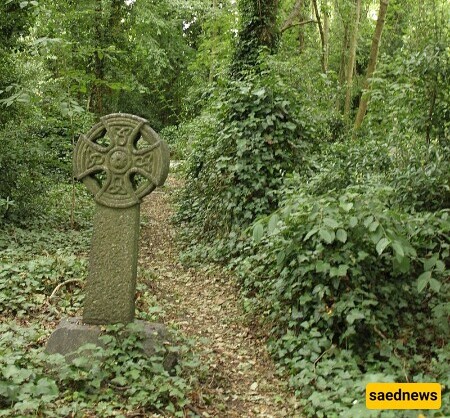SAEDNEWS: Highgate Cemetery in London is one of the historic and iconic cemeteries in North London, established in 1839.

According to SAEDNEWS, It is the final resting place of many notable figures. Known for its Gothic architecture and pristine nature, it serves not only as a site of historical significance but also as a sanctuary for birds and small animals. In this article, we’ll explore this unique location further.
Highgate Cemetery is a burial site in North London, England, designed by architect Stephen Geary. Around 170,000 people are buried in approximately 53,000 graves spread across the western and eastern sides of the cemetery. Highgate Cemetery is notable for both the individuals interred there and its informal status as a significant natural reserve. It is listed as a Grade I site in the Register of Historic Parks and Gardens.
This cemetery is located in Highgate, N6, adjacent to Waterloo Park, in the Camden area of London. It consists of two sections on either side of Swains Lane. The main gate is on Swains Lane, just north of Oakshott Avenue, with another gate on Chester Road. The closest public transportation includes bus C11, Brookfield Park stop, and Archway Underground Station.
The original layout of this cemetery—on a wooded site in northwest London—was established in 1839 as part of a plan to create seven large, modern cemeteries, now known as the "Magnificent Seven," around the outskirts of central London. Inner-city cemeteries, mostly attached to individual churches, had long been inadequate to handle the number of burials and were considered a public health hazard and an unsuitable method of dealing with the dead. The initial design was by architect and entrepreneur Stephen Geary.
On Monday, May 20, 1839, the western side of Highgate Cemetery was consecrated to St. James by Charles James Blomfield, Bishop of London. Fifteen acres were dedicated for use by the Church of England, with two acres set aside for nonconformists. Burial rights were sold for either limited periods or perpetuity. The first burial was Elizabeth Jackson from Little Windmill Street, Soho, on May 26.
Like its counterparts in the Magnificent Seven, Highgate soon became a fashionable place for burials and was widely admired and visited. Victorian attitudes toward death and its display resulted in a wealth of Gothic tombs and monuments. The cemetery occupies a south-facing hillside with a stunning view just below the summit of Highgate Hill, next to Waterloo Park.
In 1854, an additional 19 acres southeast of the original area, across Swains Lane, were purchased to form the eastern extension, which opened in 1860. Both sides of the cemetery remain in use for burials to this day. The cemetery also features a section dedicated to Muslim burials.
Let's explore some pictures of this place.









The grounds of the cemetery are filled with trees, shrubs, and wildflowers, most of which were planted but now grow naturally without human intervention. The site provides a refuge for birds and small animals like foxes.
Today, the cemetery is owned by a charitable organization, the Friends of Highgate Cemetery Trust, established in 1975. The trust acquired freehold ownership of both the eastern and western sides by 1981. In 1984, John Gay published Highgate Cemetery: Victorian Valhalla, offering further insights into this remarkable place.

